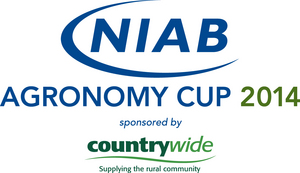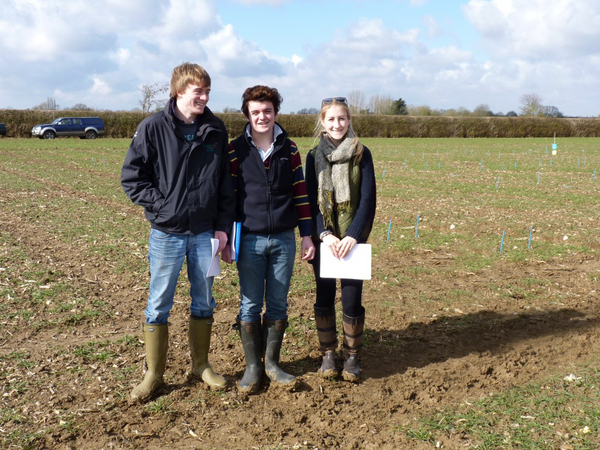
Four students studying for a BTEC Level 3 Extended Diploma in Agriculture at Easton and Otley College have won the 2013 Countrywide NIAB Agronomy Cup competition.
Open to agriculture and crop science students from universities and colleges across the UK, the competition, now partnered by Countrywide Farmers, is based on the outcome of a team’s agronomy, farm management and agricultural decision-making skills.
Captain Simon Harwood, Anna Murray, George Gay and James Cunningham beat teams from Harper Adams University, Shuttleworth College, The Royal Agricultural University and from their own Easton and Otley College. The team achieved a plot yield of 8.257 t/ha, 0.023 t/ha less than a second team from Easton and Otley College, but crucially the winners spent 30% less on fungicides.
The Countrywide NIAB Agronomy Cup is a unique trials-based agronomic input and gross margin competition that utilises NIAB’s national trials network. But it differs from other crop trial competitions as these agronomic decisions are tested on fully-replicated field plots at a NIAB trials site local to the team, rather than as a desk-based challenge or at a single central location.
Competition sites in 2013 included NIAB’s regional centres at Harper Adams, Cambridge, Sutton Scotney and at Morley, where Easton and Otley College’s plots were based. “All teams made agronomic input decisions on the winter wheat variety Horatio at a NIAB field trials site local to their college or university, with NIAB TAG trials officers applying the recommendation to the plots,” explains the competition’s co-ordinator Ian Midgley.
Replicated plots means a proper evaluation of the entrants’ decisions with the winning entry judged on the basis of improvement in margin (£/ha) compared to a standard agronomy treatment. But the real focus is on engagement between students, crop lecturers, NIAB TAG and Countrywide agronomists, and NIAB TAG trials managers.
“The teams were encouraged to use the plots as a learning opportunity through the season. They visited the plots, made their own observations and assessments of crop development and diseases, and spoke with the trial officers and agronomists to find out more about field experimental practice and crop protection practices,” said Mr Midgley.
In this way the competition emphasises the importance of field observations, basing decisions on those observations and then understanding and interpreting the results from field trials. It also shows how local conditions may lead to differing agronomic decisions compared to a national view.
However, Mr Midgley points out that nationally, 2013 was not a great year for disease identification and monitoring with little disease present, so the competition came down to the cost of the treatments recommended by each of the teams. NIAB Morley was the only competition site where the teams (Easton and Otley Team A and Easton and Otley Team B) achieved higher gross margins than the untreated and the standard treatments. The NIAB standard inputs treatment, excluding herbicides and insecticides, cost £93.50/ha, with the winning team spending £103.70/ha.
“Despite a slightly lower yield Team B were judged to be the winners as they recommended a more cost effective input strategy,” said Mr Midgley. “They spent £10.20/ha more than the NIAB standard treatment, but the return on this extra investment was £2.68 for every extra pound spent.”
The highest competition yield was actually achieved by Shuttleworth College’s Team A at NIAB Cambridge with 9.153 t/ha. NIAB Harper Adams registered the lowest yield because of the light soil and heat stress with 6.138 t/ha on the untreated plots.
Winning team captain Simon Harwood said the team enjoyed the opportunity to compete against other universities and colleges, and thanked Easton and Otley’s crop production lecturers James Trounce and Nick Johnston for all their help and encouragement.
“The competition taught us a lot about crop management; my understanding a nd knowledge of agrochemical inputs significantly improved. This included choosing fungicides with appropriate active ingredients, rather than paying extra for additional ones that the crop didn’t need. This decision was reflected in our cheap and cheerful T0 spray choice; Bravo (ai chlorothalonil) to suppress any emerging septoria. Although it was a bitterly cold spring with not much, if any, septoria developing the spray was an insurance. At £5/litre we thought it was a very small price to pay to prevent septoria establishing,” said Simon Harwood.
nd knowledge of agrochemical inputs significantly improved. This included choosing fungicides with appropriate active ingredients, rather than paying extra for additional ones that the crop didn’t need. This decision was reflected in our cheap and cheerful T0 spray choice; Bravo (ai chlorothalonil) to suppress any emerging septoria. Although it was a bitterly cold spring with not much, if any, septoria developing the spray was an insurance. At £5/litre we thought it was a very small price to pay to prevent septoria establishing,” said Simon Harwood.
Simon and the team believed the most important spray timing was the T2 GS39 spray. “The flag leaf intercepts the light and is responsible for up to 70% of the final yield. We hoped that if we could keep this clean we were in with a shot of winning. We chose a moderate rate of Adexar (epoxiconazole and fluxapyroxad) which, although the actual SDHI products were more expensive, we believed the rate we chose would be cheaper and more efficient in the long run than using non-SDHI products, without compromising grain or yield quality. Looking back, we felt we made the right decisions and wouldn’t change our original recommendations,” explained Mr Harwood.
The team wins a day out with a Countrywide agronomist to gain valuable on farm agronomic experience, free entry to a NIAB TAG Technical Conference and £100 Countrywide voucher each.
Countrywide have converted the vouchers into a cash prize at the request of the winning team who wish to donate the money to UK charity, Epilepsy Action. This follows the death of Oliver Scott-Greenard, a fellow student at Easton and Otley, who sadly passed away in November 2011.
A Sunflower Tribute Fund has been set up in Oliver’s memory – www.oliver.scott-greenard.muchloved.com, through which the prize has been donated.
Countrywide Farmers and NIAB
Countrywide Farmers have partnered with NIAB to sponsor the competition for the next three years. Entries for the 2014 competition are now being taken, including for the first time two teams of Countrywide farmer customers based at the NIAB trials sites at Cirencester in Gloucestershire and Headley Hall in Yorkshire. Student competition sites are also at Cambridge, Morley, Harper Adams, Sutton Scotney, Caythorpe and Berwick.
“We are delighted to have Countrywide Farmers on board as sponsors of the competition. The inclusion of the ‘farmer’ teams opens up a new aspect to the competition, comparing experience, skills, knowledge and innovation whilst recognising the importance of the younger generation within the industry. We’re looking forward to seeing who comes out on top,” says Mr Midgley.
“The NIAB Agronomy Cup is a unique and well established technical trials based competition, and so we jumped at the opportunity to be involved” says Paul Selby, Countrywide’s Arable Business Manager. “Over the past year, Countrywide Farmers has continued investing heavily in strengthening and expanding our arable operation and we therefore feel the NIAB Agronomy Cup is an excellent fit for the business. Our agronomists are looking forward to working with the teams in 2014, offering specialist advice and expertise to help make the more challenging agronomic decisions. The added dimension of farmers versus students should also make for an interesting and new dynamic!”
Where are the winning team members now?
- Simon Harwood (captain) is working at Salle Estate on a gap year and is waiting to attend university with a view to a career in crop protection.
- Anna Murray is working at NIAB Morley as a trials officer and is also aiming for a career in crop protection.
- George Gay is working at Stody Estate on a gap year before university.
- James Cunningham is working at Euston Estate whilst studying for a degree at Easton and Otley College.
Winning Countrywide NIAB Agronomy Cup crop recommendation
|
Timing |
Standard |
Easton and Otley Team B |
||
|
Product |
Rate (l/ha) |
Product |
Rate (l/ha) |
|
|
Fertiliser input |
As farm crop |
|
As farm crop |
|
|
T0 |
Cherokee |
1.0 |
Cherokee |
1.0 |
|
T1 |
Tracker Bravo |
1.0 1.0 |
Tracker Bravo |
1.5 1.0 |
|
T2 |
Adexar |
1.5 |
Adexar |
1.0 |
|
T3 |
Folicur |
0.75 |
Proline |
0.5 |
|
T0 PGR |
chlormequat |
1.25 |
chlormequat |
1.0 |
|
T1 PGR |
chlormequat |
1.0 |
chlormequat |
0.7 0.2 |
|
Late additional N |
- |
- |
- |
- |

